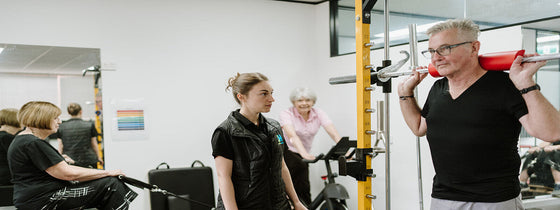At Optimal Health Lab, we’re excited to introduce a cutting-edge athletic screening designed to help athletes train smarter and perform better. This comprehensive assessment combines range of motion testing, strength profiling, force deck analysis, and a review of your current training status to create a complete performance snapshot... with an evidence-based plan to get you to the next level!
What makes this screening so powerful? It’s highly specific to the demands of your sport. Whether you’re a basketballer needing explosive jumps, a netballer focused on agility and landing mechanics, an AFL player building strength for contact, a soccer athlete chasing speed and endurance, or even a dancer striving for flexibility and control—our assessment pinpoints the areas that matter most for your performance.
By establishing a clear baseline and identifying key areas for improvement, we can tailor your training to boost performance, track essential metrics, and keep you resilient throughout the season. Perfect for preseason preparation, midseason check-ins, or anyone aiming to train smarter and reduce injury risk.
Preseason:
Preseason is more than just getting back into shape. It involves building a foundation that supports peak performance and minimizes injury risk throughout the competitive calendar. Our athletic screening assessment is designed to do exactly that by providing a comprehensive, data-driven snapshot of an athlete’s physical status before the season begins.
Here is how our screening tool can set you up for success:
Establishing a baseline:
· We assess key metrics including joint range of motion, muscle strength profiling, and force plate testing to evaluate neuromuscular control and power output.
· These objective measures give us a clear picture of your current physical condition—highlighting strengths, limitations, and areas that may require attention.
· This baseline becomes a reference point for tracking progress, monitoring adaptations, and guiding future decision-making throughout the season.
Identifying asymmetries and weak links:
· Screening can help uncover significant imbalances between limbs, muscle groups, or movement patterns that may not be obvious during regular training.
· Early detection of these possible asymmetries allows for targeted interventions before the season ramps up.
Using this information, we can develop personalised programs targeted to your specific needs to ensure you are primed and ready for any training changes, and it sets the tone for a season built on resilience, performance, and progress. This plan can be communicated with your coaches (and other members of your performance team) to see your training includes ALL the things you need to perform best!
Midseason: Staying Sharp & Managing Load
Midseason is where performance peaks and physical demands intensify. Athletes are often balancing high training volumes, competition stress, and recovery needs. This phase is critical for monitoring fatigue, adjusting workloads, and reducing the risk of overuse injuries.
Here’s how our screening tool supports athletes' midseason:
Tracking changes from baseline:
· By comparing current data to preseason benchmarks, we can detect declines in strength, explosive power, or movement efficiency.
· These changes may indicate fatigue, under-recovery, or emerging injury risk, allowing us to intervene early and prevent performance drop-offs.
Managing training loads and recovery:
· Force plate analysis provides insights into force production, landing mechanics, and asymmetries under fatigue.
· Combined with subjective training status (e.g., perceived exertion, sleep quality, soreness), we can guide deloading phases, recovery protocols, and training modifications to maintain performance.
Injury risk mitigation and performance maintenance:
· Midseason screenings help identify subtle compensations or movement pattern changes that often precede injury.
· With appropriate load management advice, recovery strategies, and program adjustments, athletes can stay sharp, reduce injury risk, and maintain consistency through the most demanding part of the season.
Postseason: Reflect, Recover & Rebuild
Postseason is the ideal time to reflect on performance, address lingering issues, and prepare for the next cycle. This phase in the sporting cycle is the ideal time to focus on long-term development.
Here’s how our screening tool adds value in the postseason:
Evaluating training load and fatigue
- Postseason assessments help identify areas that may have been overloaded or under-recovered during the season.
- This is especially important for athletes managing chronic niggles or returning from injury.
Planning off-season training:
- Objective data informs off-season programming by highlighting areas for improvement—whether it’s strength deficits, gross asymmetries, explosive power, or neuromuscular fatigue.
- This ensures that off-season work is purposeful and aligned with long-term goals
Setting the stage for next season:
· Postseason data closes the loop on the athletic year, allowing us to track progress and inform future programming.
· This cyclical approach supports year-on-year development, helping athletes build resilience, enhance performance, and enter the next season with confidence.
OHL’s athletic screening gives athletes a clear performance snapshot, identifies areas for improvement, and provides a tailored, evidence-based plan to train smarter and stay resilient. Whether you play basketball, netball, AFL, soccer, dance, or any other sport, this assessment helps you reduce injury risk and unlock your full potential. Book your 60minute Athletic Screening today and take the guesswork out of your performance journey by calling 9431 5955, or booking online now!

If you're experiencing back or neck pain with neurological signs and symptoms, a thorough neurological examination is crucial for accurate assessment and effective treatment. In this Optimal Tip learn more about what we mean by completing a neurological exam!

Squats, deadlifts, and calf raises are key movement patterns that should be part of every strength and conditioning program—regardless of age and activity level. These functional movements support joint health, improve posture and balance, and reduce the risk of injury while building strength where it matters most.

A ganglion cyst is a fluid-filled swelling that typically forms over a joint or tendon sheath, causing discomfort and pain, especially when pressing against nerves or joints. Proper assessment and treatment, including physiotherapy, are essential for managing symptoms and improving function in the presence of a ganglion in your hand, foot, or wrist.